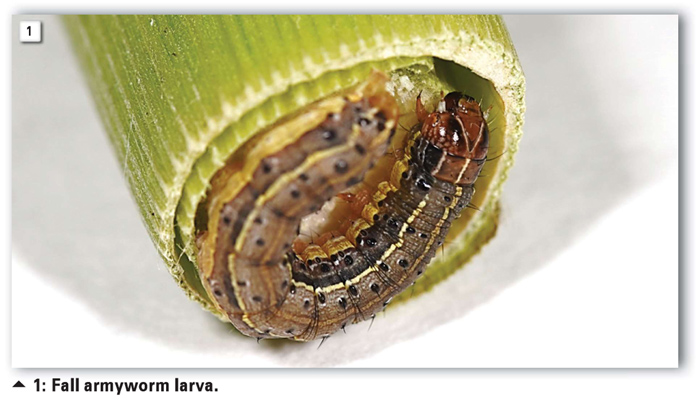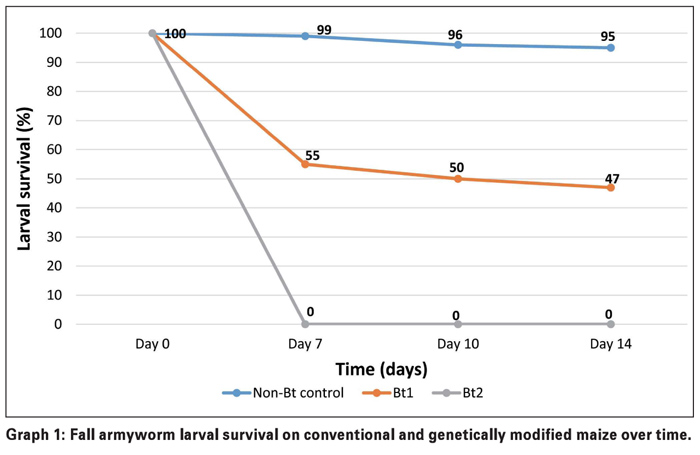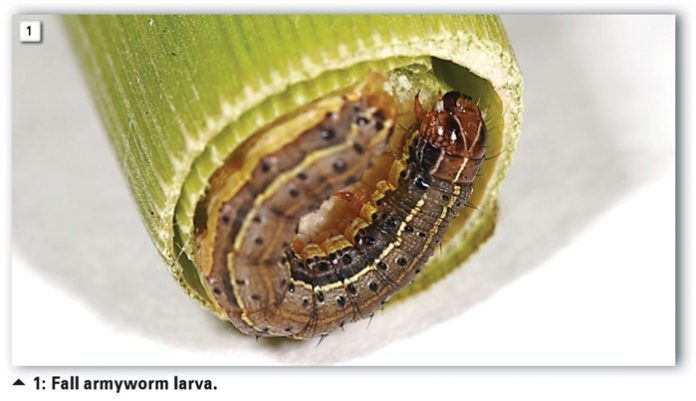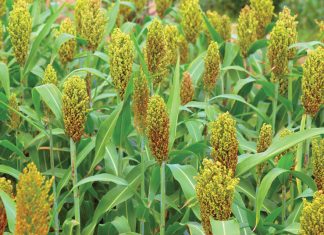October 2018
DR ANNEMIE ERASMUS, ARC-Grain Crops, Potchefstroom and PROFF HANNALENE DU PLESSIS and JOHNNIE VAN DEN BERG, integrated pest management programme North-West University, Potchefstroom
 Spodoptera frugiperda (Lepidoptera: Noctuidae) (Photo 1), the now familiar fall armyworm, has invaded South Africa during the 2016/2017 maize production season. This invasion was met with alarm, awareness was raised and planning was promptly put into place to address this new threat.
Spodoptera frugiperda (Lepidoptera: Noctuidae) (Photo 1), the now familiar fall armyworm, has invaded South Africa during the 2016/2017 maize production season. This invasion was met with alarm, awareness was raised and planning was promptly put into place to address this new threat.
The problem with invasive species such as this one is that although a vast amount of knowledge is available from the Americas, no information exists on how such a species will react and settle in the region that has been invaded. This is especially true for South Africa, which is situated towards the southern-most distribution range of this pest on the continent.
Therefore, more questions were asked than we had answers for. The question that everyone asked was: ‘How are we going to control this pest?’ To answer this important question, research needs to be conducted in South Africa, by keeping the local environment in mind and pulling together current knowledge to search for new solutions.
For example, fall armyworm was exposed to insecticide applications for decades in the Americas and it is well known that it is resistant to certain products. Similarly, this pest was also exposed to and effectively controlled with Bt maize, but it developed resistance to some products. These resistance traits could have come with the fall armyworm populations that invaded Africa.
Current local research
Some of the research fields receiving attention are: Response of fall armyworm larvae to genetically modified maize, insecticide resistance, host plant range and suitability of different South African ecological regions for pest establishment. Effective mass rearing of fall armyworm is critical to support all other research activities and time is devoted to finding cost effective rearing systems.
Larvae were collected from fields and reared on different artificial diets to determine if larvae can survive and complete its development on these diets. This is needed to rear adequate numbers of larvae to perform sound research.
Two artificial diets were compared to determine the most suitable diet for development and at the same time, provide a high survival rate to ensure successful rearing. Survival of larvae on both artificial diets was more than 90%, which proved both diets suitable for rearing fall armyworm.
 With the challenges of effective larval rearing out of the way, a pilot trial was conducted to determine larval susceptibility to genetically modified Bt maize. Larvae were inoculated onto maize whorls of a non-Bt maize plant (control), the first generation Bt maize commercialised in South Africa (Bt1) and the second generation Bt maize (Bt2).
With the challenges of effective larval rearing out of the way, a pilot trial was conducted to determine larval susceptibility to genetically modified Bt maize. Larvae were inoculated onto maize whorls of a non-Bt maize plant (control), the first generation Bt maize commercialised in South Africa (Bt1) and the second generation Bt maize (Bt2).
Larval survival on the control non-Bt maize plants was 95% after feeding for 14 days, 47% on Bt1 and 0% on Bt2 (Graph 1). From these results, it can be concluded that Bt1 will suppress the fall armyworm and Bt2 have the potential to control larval infestation.
Use of insecticides on fall armyworm
For control of fall armyworm with insecticides, it is important to adhere to the registration requirements as specified on the label. Insecticide application forms part of integrated pest management strategies and should always be used with care and attention to safety.
It is recommended to keep the following in mind:
- Make sure the product is registered for control of the target pest.
- Read the label thoroughly.
- Apply the correct dosage, water volume, with the correct size nozzle.
- Determine the best time for optimal control.
Success of control should also be monitored after application. Preventative sprays for fall armyworm are not viable since the presence of the pest cannot be predicted and it will lead to resistance development against insecticides.
Biological control
A highlight of the past two seasons is that, although it is an invasive species, the local natural enemies also started to attack fall armyworm. A few parasitoids were reared from fall armyworm larvae sampled from the field. The most promising discovery was an egg parasitoid.
This parasitoid, which parasitises eggs of fall armyworm, is also present and used in the Americas as biological control agent for fall armyworm, where it is reared and then released in the field to control the pest. It is good news since this parasitoid is present here and if chemical control is applied with care to protect this invasive parasitoid, it can act as biological control of fall armyworm in South Africa.
There is thus potential for biological control of the fall armyworm in South Africa to be included in an integrated pest management system for this pest in South Africa.
Harmful polyphagous pest
It is internationally known that fall armyworm is polyphagous, which means that this pest can attack a wide range of crop plants. It is reported that this pest attacks over 80 plant species representing more than 20 plant families. However, it has a definite preference for grass crops and will probably confine its attack to these crops if continuously available. Because of its wide host range, this species is one of the most harmful pests threatening annual crops in tropical regions.
During the past two seasons in South Africa fall armyworm was reported on potatoes, soybean, sugarcane, wheat and sorghum. In these cases, damage was low and it is not known if fall armyworm has the ability to complete its life cycle on these crops. However, maize still remains the most preferred crop on which serious damage was reported.
Integrated pest management still the answer
While research on the fall armyworm is still ongoing even more questions arise, which requires more research. It should be emphasised that an integrated pest management approach will always be the best option for control of any pest – and therefore also for the fall armyworm. However, the current approach to keep this pest under control is to apply good integrated pest management practices.
 This means that producers should keep up to date regarding the possible invasion of a particular area, do scouting of fields for infestation and apply pesticides judiciously and only when needed. There is no single control measure to manage fall armyworm and control practices should be integrated.
This means that producers should keep up to date regarding the possible invasion of a particular area, do scouting of fields for infestation and apply pesticides judiciously and only when needed. There is no single control measure to manage fall armyworm and control practices should be integrated.
Publication: October 2018
Section: On farm level


















